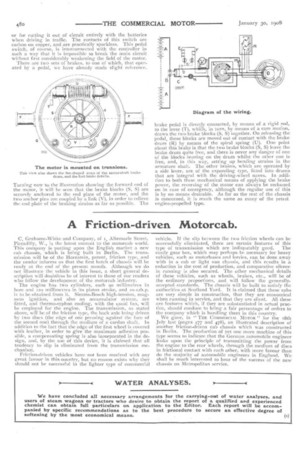A Friction-driven Motorcab.
Page 18

If you've noticed an error in this article please click here to report it so we can fix it.
C. Grahame-White and Company, of 1, Albemarle Street, Piccadilly, W., is the latest entrant to the motorcab world, This company is putting upon the English market a new cab chassis, which is being built in Berlin. The transmission will be of the Hornstein, patent, friction type, and the vendor informs us that the first hatch of chassis will be ready at the end of the present month. Although we do not illustrate the vehicle in this issue, a short general description will doubtless be of interest to those of our readers who follow the development of the motorcab industry.
The engine has two cylinders, each 90 millimetres in bore and 120 millimetres in its piston stroke, and io-12h.p. is to be obtained from it. Simms-Bosch high-tension, magneto ignition, and also an accumulator system, are fitted, and thermo-syphon cooling, with the usual fan, will he employed for the engine. The transmission, as stated above, will be of the friction type, the back axle being driven by two discs (the edge of one pressingagainst the face of the second one) through the Medium of a cardan shaft. In addition to the fact that the edge of the first wheel is covered with leather, in order to give the maximum adhesion possible, a compensating spring is also incorporated in the design, and, by the use of this device, it is claimed that all tendency to slip is eliminated from the transmission mechanism.
Friction-driven vehicles have not been received with any great favour in this country, but no reason exists why they should not be successful in the lighter type of commercial vehicle. If the slip between the two friction wheels can be successfully eliminated, there are certain features of this
type of transmission which are indisputably good. The costly gear box, which may perhaps be necessary for heavy vehicles, such as Tnotorhuses and lorries, can be done away with in a nab or light van chassis, and this results in a reduction in the cost of production, and comparative silence in running is also secured. The other mechanical details of these vehicles, such as wheels, brakes, etc., will be of the ordinary proportions, and will follow the generallyaccepted standards, The chassis will be built to satisfy the authorities at Scotland Yard. It is claimed that these cabs are very simple in construction, that they are economical when running in service, and that they are silent. All these are features which, if they are substantiated in actual practice, should conduce to bring a fair percentage of orders to the company which is handling them in this country. We gave, in " THE COMMERCJAL MOTOR " for the 18th July last (pages 477 and 478), an illustrated description of another friction-driven cab chassis which was constructed in Berlin, The production of yet one more machine of this type seems to indicate that the German automobile engineer looks upon the principle of transmitting the power from the engine to the rear wheels, through the medium of discs in frictional contact with each other, with more favour than do the majority of automobile engineers in England. We shall be much interested to hear of the success of the new chassis on Metropolitan service.




















